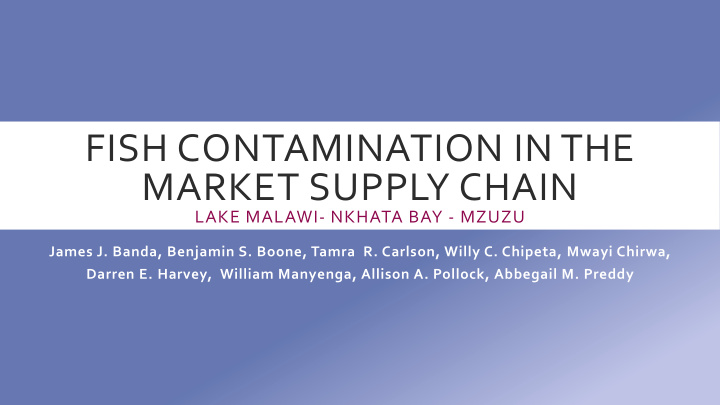



FISH CONTAMINATION IN THE MARKET SUPPLY CHAIN LAKE MALAWI- NKHATA BAY - MZUZU James J. Banda, Benjamin S. Boone, Tamra R. Carlson, Willy C. Chipeta, Mwayi Chirwa, Darren E. Harvey, William Manyenga, Allison A. Pollock, Abbegail M. Preddy
INTRODUCTION
1978 study by C.C. Rao and S. Gupta and the Kakinada Research Center (India)
Most E Coli at market Out of 126 total samples: 4 samples of fishermen 5 samples during transit 7 samples at market
Hypothesis: Mzuzu and Nkhata Bay supply chains will follow the same pattern Pilot study for more in depth future research
Fish provides over 60% of the dietary animal protein intake and 40% of the total protein supply. (Press Cooperation Limited, 2007)
Fisheries sector directly employs 50,000 fishermen and indirectly 350,000 people involved in fish processing, fish marketing, net making, boat building and engine repair. (Kanyerere et al., 2009)
Quality management is not well developed due to the shortage of trained/skilled personnel. (Kapute, 2008)
Food source is hampered by poor and inadequate food safety and handling practices - shelf life of not more than 48 hours. (Ashie et al., 1996; Ghaly et al., 2010)
METHODOLOGY
PREPARATION
FISHERMEN
INTERVIEWING
MIDDLEMEN EXCHANGE
RETURN OF THE FISHERMEN
MIDDLEMEN TRANSIT
MARKET SAMPLING NKHATA BAY
WATER SAMPLING NKHATA BAY
MARKET SAMPLING MZUZU
SAMPLE PROCESSING
DATA COUNTING
RESULTS
Fishermen Water in Boat (n=6) Fishermen Max: 12,500 colonies per 100ml 4 4 Hands (n=8) 12500 Max: 72 cfu per 10 x 10 cm 72 Surface of Boat (n=6) Max: 4 cfu per 10 x 10 cm Fish (n=6) Max: 4 cfu per 10 x 10 cm *all minimums equal to 0 cfus
Transit Fishermen Hands (n=4) Max: 8 cfu per 10cm x 10cm 4 4 12500 72 Container (n=4) Max: 0 cfu per 10 x 10 cm Transit Fish (n=1) 8 Max: 0 cfu per 10 x 10 cm *all minimums equal to 0 cfus
Market: Nkhata Bay Wash Water (n=1) Fishermen Max: 2400 colonies per 100ml 4 4 Surface (n=2) 12500 Max: 8 cfu per 10 x 10 cm 72 Fish (n=2) Market: Nkhata Bay Max: 4 cfu per 10 x 10 cm 4 2 Transit 2400 Hands (n=2) 8 Max: 2 cfu per 10 x 10 cm 8 Container (n=1) Max: 0 cfu per 10 x 10 cm *all minimums equal to 0 cfus
Market: Market: Mzuzu Mzuzu 350 12 Wash Water (n=2) Fishermen Max: 350 colonies per 100ml 4 4 Surface (n=2) 12500 Max: 12 cfu per 10 x 10 cm 72 Fish (n=2) Market: Nkhata Bay Max: 0 cfu per 10 x 10 cm 4 2 Transit 2400 Hands (n=2) 8 Max: 0 cfu per 10 x 10 cm 8 Container (n=1) Max: 0 cfu per 10 x 10 cm *all minimums equal to 0 cfus
RESULTS: FISHERMEN/ TRANSIT SURVEYS 44% of fishermen/middlemen use the lake for the bathroom Only 12% use market toilets 79% of fishermen/middlemen do not use soap 88% of fishermen/middlemen use the lake for washing hands
RESULTS: FISHERMEN/ TRANSIT SURVEYS 100% of fishermen & middlemen believe there are no health issues with the market fish 100% of fishermen & middlemen are interested in training on food safety
RESULTS: MARKET SURVEYS 66% of market sellers do not wash hands with soap 66% wash hands after handling fish, but not before 89% of market sellers keep fish greater than one day through heating/drying methods
RESULTS: MARKET/ CUSTOMER SURVEYS 100% of sellers think there are no health risks with eating market fish 2 out of 4 customers surveyed have gotten sick from eating fish 100% of market sellers and customers said they would be interested in training about food safety
LIMITATIONS
Complexity of supply chain
Logistics of finding fishermen and following fish
Time and sample size constraints
DISCUSSION
Not as far along the fish supply chain as originally hypothesized Majority of E Coli found in the fishermen’s boats and hands Possibly follow the fishermen supply chain instead of fish supply chain
Greater chance of contamination on the busier days Major drop in E Coli found as the activity slowed during the week Make sure to clean boats prior to the busiest days
Large amount of coliform, small amount of E Coli
CONCLUSION
E Coli and other coliform are an issue, but not where originally hypothesized Logistics of the fish market supply and value chain are very complex Many hands, many markets, many boats Pilot study for more in-depth research and analysis
Possible future steps to take: 1. Follow both supply chains in more detail 2. Educate the fishermen on major contamination points 3. Further studies on other possible contaminants (salmonella, listeria)
REFERENCES Ashie INA, Smith JP, Simpson BK (1996). Spoilage and shelf life extension of fresh fish and shell fish. Crit. Rev. Food Sci. Nutr. 36(1- 2):87-121. http://directresearchpublisher.org/wp-content/uploads/2016/02/DRJA32237331.pdf Kanyerere GZ, Banda MC, Chilora B, NyasuluTE, Ngochera MJ, Kaonga D (2009). Annual Frame Survey Report. Fisheries Bulletin No. 60, Department of Fisheries, P.O. Box 593, Lilongwe, Malawi. Retrieved at http://www.lakechilwaproject.mw/admin/modules/reports/archive/Frame%20Survey%20Country%20wide%202008%20Final%20ver.pdf . Kapute, F (2008). Fish Quality and Processing in Malawi: Responding to Challenges Through Institutional Capacity Building. The United Nations University, Fisheries Training Programme. Online access at http://www.unuftp.is/static/fellows/document/fanue08prf.pdf Press Cooperation Limited (2007). Online access at http://www.presscorp.com/index.php?module=htmlpages&func=display&p id=14.
Recommend
More recommend